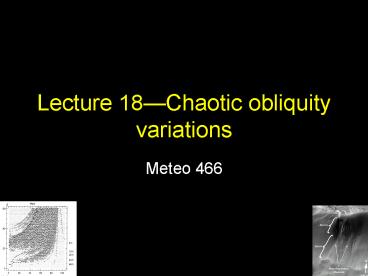Lecture 18Chaotic obliquity variations - PowerPoint PPT Presentation
1 / 23
Title:
Lecture 18Chaotic obliquity variations
Description:
Chaos: Mathematically, this term is used to describe dynamical systems in which ... Need to observe them in concert with their planetary companions ... – PowerPoint PPT presentation
Number of Views:35
Avg rating:3.0/5.0
Title: Lecture 18Chaotic obliquity variations
1
Lecture 18Chaotic obliquity variations
- Meteo 466
2
Definition of chaos
- Chaos Mathematically, this term is used to
describe dynamical systems in which small changes
in initial conditions lead to large changes in
the solution after some period of time - Examples of chaotic systems
- The weather (the Butterfly effect)
- Double pendulum
- The geodynamo (or solar dynamo)
- The inner Solar System ?
3
Chaos in the Solar System
- 25 b.y. integration of planetary orbits
- Semi-analytic numerical method
- Series expansion of Laplaces equation to
150,000 terms. Keep the first 50,000
J. Laskar, AA 287, L9 (1994)
4
Mercury escapes from the Solar System
Laskar (1994)
5
Causes of chaotic obliquities
- A planets obliquity can vary chaotically if the
the planets spin axis precesses at the same rate
as do orbital characteristics of other planets - Two types of secular resonances
- Precession of perihelion
- Precession of the line of nodes
(1)
a
(2)
?
S
6
Secular forcing frequencies in the Solar System
- Orbits in the inner Solar System are chaotic, so
the forcing pattern is complex - Orbits in the outer Solar System are periodic, so
the forcing pattern is more regular
Laskar and Robutel (1993)
7
Chaotic regions for Mars
- 18 m.y. simulations beginning at specified
precession constants and obliquities - Solution can wander horizontally within the
fuzzy region - Precession constant inversely related to spin
period - Martian daylength 24.6 hr
Chaotic region
Precession constant, /yr
Present Mars
Obliquity
Laskar and Robutel (1993)
8
Mars recent obliquity
Inclination
? 8.26/yr
? 8.32/yr
Ward and Rudy, Icarus 94, 160 (1991)
9
Mars recent obliquity(alternative calculation)
Touma and Wisdom, Science 259, 1294 (1993)
10
Possible consequences of martian obliquity
variations
- Could obliquity variations be responsible for the
martian gullies? - Gullies (small-scale fluvial features) are found
predominately at high latitudes on
poleward-facing slopes
11
Recent Martian Gully Locations(from Mars Global
Surveyor)
M.C. Malin and K.S Edgett, Science (2000)
12
MOC Images (Mars Global Surveyor)
Fig. 2 Crater wall (54.8oS, 342.5oW)
M. Malin and K. Edgett, Science (2000)
13
MOC Images
Fig. 4 Crater wall (37.3oS, 168.0oW)
Malin and Edgett (2000)
14
Nirgal Vallis apron
MOC Images
Malin and Edgett (2000)
Fig. 9
15
- Unfortunately for the obliquity hypothesis, some
of the gullies appear to have formed essentially
yesterday
16
New Martian Gullies (from Mars Global Surveyor)
http//www.nasa.gov/vision/universe/solarsystem/mg
s-092005-images.html?msource15205tryauid11148
46
17
- Back to Earth
- Earths obliquity is stable, but that might not
be the case if it did not have a large Moon - Ward and Brownlee have emphasized this in their
book Rare Earth - Moon forming impacts are rare hence, planets
with stable obliquities may be rare
18
Secular forcing for Earth
- Earths precession constant is 55/yr, which is
just outside the chaotic region chaos occurs
when the secular forcing is minus (or plus?) the
precession rate - If the Moon were not present, however, the
precession constant would be lower (15/yr), and
Earths spin axis would precess in resonance with
the secular forcings
Earth with Moon
No Moon
J. Laskar et al., Nature (1993)
19
Earths obliquity with and without the Moon
Chaotic region
Daylength (with no moon)
Laskar and Robutel, Nature (1993)
20
- Does this mean that a Moon-less planet would have
a chaotic obliquity? - Earths spin rate has been slowed over time by
tidal evolution of the Earth-Moon system - Initial spin rate (after the Moon-forming impact)
was probably 4-5 hours - Spin rates faster than 12 hours lead to stable
obliquity - What would the initial spin rate have been,
though, in the absence of a Moon-forming impact?
21
Would a high-obliquity planet be habitable?
- Continents at high latitudes would be alternately
baked and frozen - Tropical continents would experience 2 summers
and 2 winters
Williams Kasting, Icarus (1997)
22
Would a high-obliquity planet be habitable?
- Planets near the outer edge of the HZ that
develop dense, CO2-rich atmospheres would
experience much smaller temperature variations - Marine life would be virtually unaffected by high
obliquity
2 bars CO2
Williams Kasting (1997)
23
Conclusions
- Mars obliquity varies chaotically, but that
probably isnt what causes the gullies - Earths obliquity varies regularly, but that is
more or less accidental - Other (extrasolar) planets could have either
regular or chaotic obliquities. Need to observe
them in concert with their planetary companions - Because most O2 comes from marine photosynthesis,
the search for microbial life on extrasolar
planets should be virtually unaffected by
obliquity































